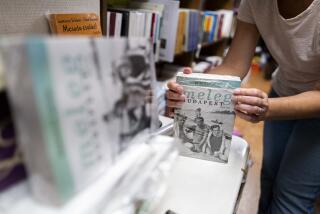ART SHOW : Hungarian artists are featured in an exhibit from another time and place.
- Share via
From a time when Budapest was still one of the important cultural centers in Europe comes an exhibit of 51 works by Hungarian graphic artists who were attempting to distinguish and define their national art.
The Laband Art Gallery of Loyola Marymount University opens its 1993-94 season with “The Metropolis or the Meadow? Modernist Polarities in Hungarian Graphic Art 1915-1940.” An opening reception for the show sponsored by the consulate general of Hungary in Los Angeles will be from 4 to 6 p.m. Saturday. The exhibit opened Wednesday and runs through Oct. 9.
The show includes images by four photographers as well as etchings, woodcuts and linocuts that reflect the two poles of Hungarian modernism, said Gordon Fuglie, Laband gallery director and curator of the show.
The exhibit explores urban, post-industrial works that may be more familiar to American audiences, but it also emphasizes the work of artists who lived in rural colonies and whose portraits and pictorial work have been somewhat overlooked here.
Some of the 20 artists in the show were influenced by the French Impressionist movement, in which light and tone dominated detail. Others were influenced by the abstraction of Soviet Constructivism. All the artists fused foreign influences with their own distinctive aesthetic, creating works defined by national pride during a time of turmoil.
The “metropolitan” or industrial art in the exhibit often has a utopian theme as the artists were “looking to cities as holding technology that could be tamed and used to improve people’s lives,” Fuglie said.
But many of the works were created during the turbulent times after World War I and the 1918 revolution in Hungary. The borders of Hungary were redrawn after World War I, reducing the country’s land and population by 60%, Fuglie said.
The artistic reaction to repressive times includes a series of 11 woodcuts by Gyula Derkovits called “1514.” While the work ostensibly re-creates a peasant uprising several centuries earlier, Derkovits’ interpretation of the event becomes a Communist call to arms against the 1920 Fascist government.
Perhaps the best known name in the exhibit is Laszlo Moholy-Nagy, a photographer who also experimented with kinetic sculpture. Moholy-Nagy became fixture at the Bauhaus school and in the late 1930s opened the New Bauhaus in Chicago.
The exhibit features a black and white photograph by Moholy-Nagy, an aerial view of downtown Marseille in 1929 that clearly demonstrates Constructivist influence, Fuglie said.
Also featured in the show are two portfolios of etchings; one is a group of a dozen self-portraits by various artists and the second is a portfolio of landscape etchings that depict 10 artists’ passion for the land or “Magyar” and for the nation.
The exhibit, sponsored in part by the Marymount Institute for Faith, Culture and the Arts, is taking place in conjunction with “Crisis of Cultures and the Birth of Faith,” a conference scheduled Sept 25-26.
The Laband Art Gallery is in the Fritz B. Burns Fine Arts Center at Loyola Boulevard and West 80th Street. Gallery hours are 11 a.m to 5 p.m. Wednesday through Friday and noon to 4 p.m. Saturday. Information: (310) 338-2880.
More to Read
The biggest entertainment stories
Get our big stories about Hollywood, film, television, music, arts, culture and more right in your inbox as soon as they publish.
You may occasionally receive promotional content from the Los Angeles Times.










